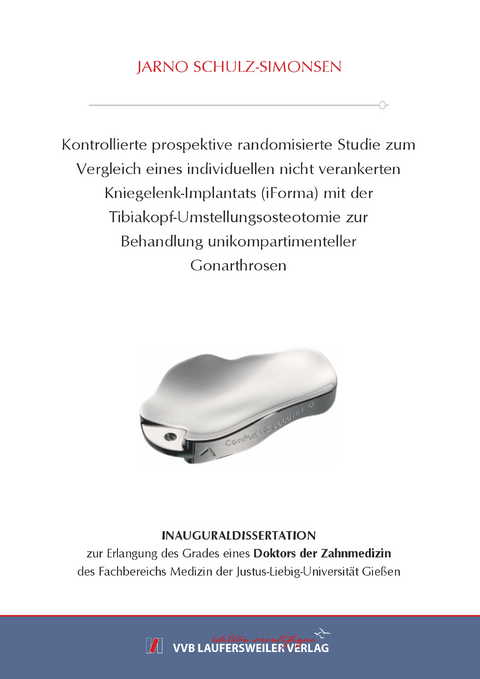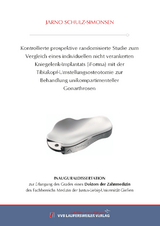Kontrollierte prospektive randomisierte Studie zum Vergleich eines individuellen nicht verankerten Kniegelenk-Implantats (iForma) mit der Tibiakopf-Umstellungsosteotomie zur Behandlung unikompartimenteller Gonarthrosen
Seiten
2021
VVB Laufersweiler Verlag
978-3-8359-7007-6 (ISBN)
VVB Laufersweiler Verlag
978-3-8359-7007-6 (ISBN)
- Keine Verlagsinformationen verfügbar
- Artikel merken
Zwischen September 2004 und September 2007 wurden 22 Patienten mit einer unilateralen Arthrose des Kniegelenkes in eine kontrollierte randomisierte Studie eingeschlossen und die postoperativen Ergebnisse nach der Implantation eines individuell geformten, unverankerten unilateralen Knie-Implantats aus Metall (iForma, n = 13) oder nach einer valgisierenden Hohen Tibiakopf-Osteotomie (HTO, n = 9) untersucht. Als Parameter des Outcomes wurden drei, sechs, zwölf und 24 Monaten nach dem Eingriff die funktionellen Beschwerden und Schmerzen mit den klinischen Scores Knee-Society-Score (KSS), Western Ontario and McMaster Universities Arthritis Index (WOMAC), Visuelle-Analog-Skala für Schmerz (VAS) und die subjektiven Patientenzufriedenheit bestimmt. Da die Studie in Abstimmung mit der Ethikkommission wegen unerwünschter Ereignisse in der iForma-Gruppe vorzeitig beendet wurde, reduzierten sich die Patientenzahlen.
Der Mittelwert des KSS verbesserte sich 24 Monate postoperativ in beiden Behandlungsgruppen von 108 (HTO), bzw. 111 (iForma) auf 166, bzw. 163. In beiden Gruppen verbesserten sich die Mittelwerte des WOMAC nach 24 Monaten ebenfalls. In der iForma-Gruppe von 51 auf 20,1 und in der HTO-Gruppe von 43,6 auf 16,4. Die VAS für Schmerz verbesserte sich über den Beobachtungszeitraum in beiden Gruppen signifikant und erreichte in der iForma-Gruppe einen Mittelwert von 8,62, ausgehend von 24,9. In der HTO-Gruppe verbesserte sich der Wert von 22,2 auf 9,67. Keiner der untersuchten Parameter unterschied sich signifikant zwischen den Behandlungsgruppen. Weiter fehlten signifikante Unterschiede bei der subjektiven Patientenzufriedenheit. In der iForma-Gruppe trat im Vergleich zur HTO-Gruppe ein signifikant höheres Streckdefizit auf. Die mittlere Operationsdauer lag in der iForma-Gruppe mit 46,1 min signifikant niedriger als in der HTO-Gruppe (95,8 min).
Bei neun Patienten verblieb das Implantat bis zum Ende des Beobachtungszeitraums. In vier Fällen (31 %) musste das iForma-Implantat innerhalb der ersten zwölf Monate entfernt werden. Aufgrund der hohen Anzahl unerwünschter Ereignisse ist derzeit nicht davon auszugehen, dass individuell angepasste, unverankerte Implantate, eine gelenkerhaltende Therapieoption bei unilateralen Gonarthrosen darstellen. Between September 2004 and October 2007, 22 patients were recruited for a controlled clinical study at the Department for Orthopedics and Orthopedic Surgery at the University Hospital of Giessen. 13 of the patients were randomly assigned to the test group, nine to the control group. The aim of the study was to compare the clinical outcomes of treatment of unicompartmental gonarthrosis with a knee-implant (iForma) and the experiences of the open-wedge-osteomy (HTO). After three, six, twelve and 24 months, the Knee-Society-Score (KSS), Western Ontario and McMaster Universities Arthritis Index (WOMAC), Visual-Analogue-Scale for pain (VAS) as well as questions regarding subjective patient assessment were documented and statistically analyzed. Further, possibly insufficient extension and the duration of the operative procedure were reported. Since the study was finished prematurely in coordination with the ethics committee due to adverse events in the iForma group, the number of subjects was limited.
The postoperative mean KSS improved its value from 108 (HTO), respectively 111 (iForma) to 166, respectively 163 after 24 months. The WOMAC in the iForma-group had an improvement of the mean value from 51 to 20.1 and in the HTO-group from 43.6 to 16.4. The VAS for pain improved during the period of observation in both groups significantly, and peaked in the HTO-group with an improvement of the mean value from 22.2 to 9.67 and in the iForma-group from 24.9 to 8.62. Regarding subjective patient contentment, no significant differences between the two groups were found. Insufficient extension was significantly more prevalent in the test group than in the control group. The average duration of procedure was significantly longer in the control group (95.8 min) than in the test group (46.1 min).
Indeed, statistical calculations do not show significant differences between the two groups. However, that does not consider failures. The iForma-implants has been removed in four of 13 cases, which is equivalent to a loss ratio of 31 %. In view of these numbers, it is not expected that custom built implants are a safe option for a joint-conservative treatment of unilateral gonarthrosis.
Der Mittelwert des KSS verbesserte sich 24 Monate postoperativ in beiden Behandlungsgruppen von 108 (HTO), bzw. 111 (iForma) auf 166, bzw. 163. In beiden Gruppen verbesserten sich die Mittelwerte des WOMAC nach 24 Monaten ebenfalls. In der iForma-Gruppe von 51 auf 20,1 und in der HTO-Gruppe von 43,6 auf 16,4. Die VAS für Schmerz verbesserte sich über den Beobachtungszeitraum in beiden Gruppen signifikant und erreichte in der iForma-Gruppe einen Mittelwert von 8,62, ausgehend von 24,9. In der HTO-Gruppe verbesserte sich der Wert von 22,2 auf 9,67. Keiner der untersuchten Parameter unterschied sich signifikant zwischen den Behandlungsgruppen. Weiter fehlten signifikante Unterschiede bei der subjektiven Patientenzufriedenheit. In der iForma-Gruppe trat im Vergleich zur HTO-Gruppe ein signifikant höheres Streckdefizit auf. Die mittlere Operationsdauer lag in der iForma-Gruppe mit 46,1 min signifikant niedriger als in der HTO-Gruppe (95,8 min).
Bei neun Patienten verblieb das Implantat bis zum Ende des Beobachtungszeitraums. In vier Fällen (31 %) musste das iForma-Implantat innerhalb der ersten zwölf Monate entfernt werden. Aufgrund der hohen Anzahl unerwünschter Ereignisse ist derzeit nicht davon auszugehen, dass individuell angepasste, unverankerte Implantate, eine gelenkerhaltende Therapieoption bei unilateralen Gonarthrosen darstellen. Between September 2004 and October 2007, 22 patients were recruited for a controlled clinical study at the Department for Orthopedics and Orthopedic Surgery at the University Hospital of Giessen. 13 of the patients were randomly assigned to the test group, nine to the control group. The aim of the study was to compare the clinical outcomes of treatment of unicompartmental gonarthrosis with a knee-implant (iForma) and the experiences of the open-wedge-osteomy (HTO). After three, six, twelve and 24 months, the Knee-Society-Score (KSS), Western Ontario and McMaster Universities Arthritis Index (WOMAC), Visual-Analogue-Scale for pain (VAS) as well as questions regarding subjective patient assessment were documented and statistically analyzed. Further, possibly insufficient extension and the duration of the operative procedure were reported. Since the study was finished prematurely in coordination with the ethics committee due to adverse events in the iForma group, the number of subjects was limited.
The postoperative mean KSS improved its value from 108 (HTO), respectively 111 (iForma) to 166, respectively 163 after 24 months. The WOMAC in the iForma-group had an improvement of the mean value from 51 to 20.1 and in the HTO-group from 43.6 to 16.4. The VAS for pain improved during the period of observation in both groups significantly, and peaked in the HTO-group with an improvement of the mean value from 22.2 to 9.67 and in the iForma-group from 24.9 to 8.62. Regarding subjective patient contentment, no significant differences between the two groups were found. Insufficient extension was significantly more prevalent in the test group than in the control group. The average duration of procedure was significantly longer in the control group (95.8 min) than in the test group (46.1 min).
Indeed, statistical calculations do not show significant differences between the two groups. However, that does not consider failures. The iForma-implants has been removed in four of 13 cases, which is equivalent to a loss ratio of 31 %. In view of these numbers, it is not expected that custom built implants are a safe option for a joint-conservative treatment of unilateral gonarthrosis.
| Erscheinungsdatum | 18.01.2022 |
|---|---|
| Reihe/Serie | Edition Scientifique |
| Verlagsort | Gießen |
| Sprache | deutsch |
| Maße | 148 x 210 mm |
| Gewicht | 180 g |
| Themenwelt | Medizin / Pharmazie ► Zahnmedizin |
| Technik ► Maschinenbau | |
| Schlagworte | Arthrose • Implantat • Knie |
| ISBN-10 | 3-8359-7007-0 / 3835970070 |
| ISBN-13 | 978-3-8359-7007-6 / 9783835970076 |
| Zustand | Neuware |
| Haben Sie eine Frage zum Produkt? |
Mehr entdecken
aus dem Bereich
aus dem Bereich
Buch | Spiralbindung (2023)
Asgard (Verlag)
CHF 55,95
Lokalanästhesie, Analgesie, Sedierung
Buch | Hardcover (2024)
QUINTESSENZ Verlag
CHF 113,80
BEL II mit ausführlichem Expertenkommentar sowie Erläuterungen und …
Buch | Spiralbindung (2023)
Spitta GmbH (Verlag)
CHF 219,95




